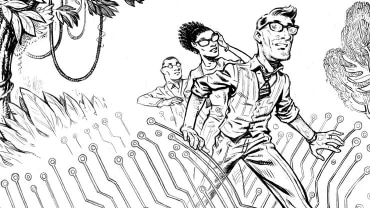
The right CDO for your company's future: The five archetypes of a chief digital officer
Executive summary
As companies move to catch up with the digital future, they are taking a close look at what kind of executive they need to lead the way. More and more frequently, that executive is the chief digital officer, or CDO — although there are some variations in the actual title. It is that person’s task to define the company’s digital strategy and execute its cross-functional transformation into a fully digital enterprise.
But companies that are still searching for a CDO (and even some that have already appointed a digital leader, if only temporarily) continue to struggle to find the executive who best fits their strategic goals, digital business model, and current and digital capabilities and operations. It is, after all, a tall order, and the executive must step into this newly created position with the experience, personality, leadership abilities, and aggressiveness needed to carry out the necessary transformation.
The key question for these companies: What do they want their digital leader to accomplish? In order to help companies in their efforts to find the right CDO, we have defined five CDO “archetypes” — the progressive thinker, the creative disrupter, the customer advocate, the innovative technologist, and the universalist. These model types are not meant to be examples of specific executives a company might hire, but rather to serve as an indication of the CDO’s potential range of roles and responsibilities.
Choosing the right digital leader is critical to true digital success. At the same time, to attract the best talent, companies must demonstrate to candidates that they have the top-level commitment, digital strategy, governance model, and transformation road map in place to enable the CDO to succeed in his or her mission.
The right stuff
Executives in virtually every industry are finally coming to understand just how extensively the digital revolution is restructuring their competitive landscape. They recognize the advantage of not merely participating in the transformation but leading the way. They realize that digitization means changing the ways they interact with customers, partners, and suppliers, and dramatically rethinking their internal practices, behaviors, and processes to accomplish this. And they have come to acknowledge that digitization isn’t just about revamping IT and marketing. The demands of digitization will ultimately force companies to transform virtually every aspect of their business.
However, unless companies can clearly define their paths to digitization, and the capabilities they will need to get there, they will likely fail to implement the necessary transformation of their strategy, their operations, and their cultures. That’s where the chief digital officer comes in. We define this executive as the digital leader, no matter the title — CDO, chief information officer (CIO), chief marketing officer (CMO), vice president of digital, or something else — whose presence is critical in defining his or her company’s strategic direction and bringing about its cross-functional transformation into a fully digital enterprise.
Yet many companies are at a loss when it comes to defining that role as it applies to their current level of digital maturity, or Digital IQ, as defined in our annual Digital IQ Survey1: that is, their digital strategy going forward, and the extent and direction of the transformation required to set them on the proper course. And defining the position clearly, even at companies that have already put a CDO in place, is becoming increasingly critical. Companies are spending more and more money on digital technologies outside the CIO’s traditional IT domain — in 2015, 68 percent of all digital spending came from non-IT departments, while in 2014 only 47 percent came from outside IT.2
And when it comes to CDOs, one size does not fit all. Every company must carefully decide on the type of digital leader that best fits its strategic goals, its digital business model, and the current and future state of its digital capabilities and operations, as well as the candidate’s experience, personality, and transformational aggressiveness. Many companies have turned to one or another executive already in place — the CIO or CMO, for instance — to perform this function, in hopes that this person can expand his or her current role to cover the demands of digitization across the entire company. But many, we believe, will continue to look for a true digital leader who can really unite the business and technology sides of their operations, across all functions and business units — and this might require looking outside for the right person.
If companies are to find that executive, whether internally or from outside, they must consider several factors: the roles and responsibilities required; how their organization is structured, and how it should be; the governance model needed to give the CDO the authority to carry out the digital strategy and transformation; the cultural hurdles the new CDO will face; the new digital technologies needed; and even how to measure the success of their digital transformation. And they must bear in mind that the CDO position is so new that they can’t rely on past experience in finding one, as they would in searching for a new chief operating officer (COO) or CIO.
Instead, the best way to approach the role is with a fresh perspective. First you develop a complete understanding of the digital trends disrupting your industry and business, and the transformational challenge the company faces as it works out the existing and future differentiating capabilities needed to carry out a winning strategy for the digital age. Only after identifying all of these details should a company define the profile of the executive whose experience and expertise best fit the bill.
Digitization is more than just a technology trend; it’s a transformation of society and the economy as a whole, and it requires immediate action by every company to keep up with the pace of change. A CDO can provide this needed sense of urgency. Only by choosing the right CDO for the job at hand can companies hope to lead the way to the digital future.
Conclusion
As the demand for CDOs rises, the competition for the best ones will only intensify. Yet many companies remain unsure of what they want or need in a digital leader. The key lies in understanding where you stand on your path to digital maturity and having the outlines of a strategy and transformation plan that will get your company there. With that knowledge in hand, you will be able to define much more clearly the kind of CDO who will best take you down that path. The five archetypes we have described should provide both a guide to help you define who that CDO should be and a deeper understanding of how the person you hire can best carry out his or her role.
1“2015 Global Digital IQ Survey,” PwC, 2015.
2“2015 Global Digital IQ Survey,” PwC, 2015.






